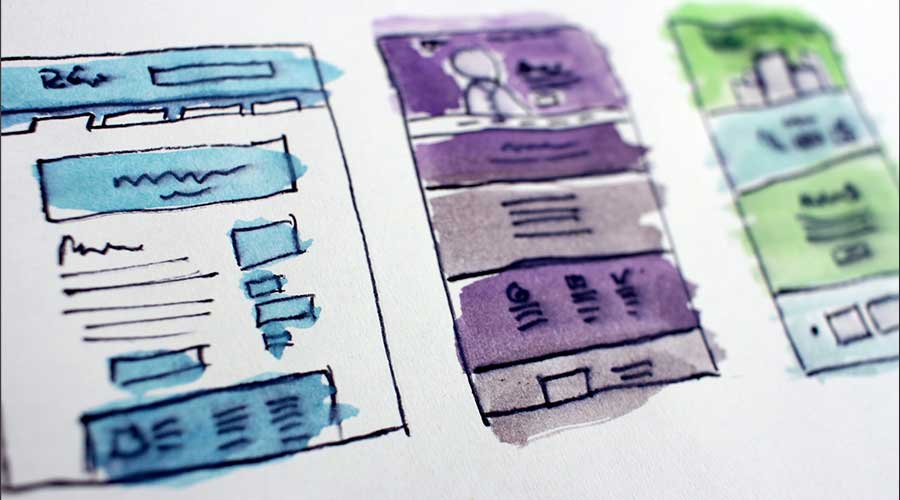A good website is the cornerstone of business for many companies. Its creation, however, is not easy. It is useful to have knowledge in various fields – from psychology to design to programming.
Here you will find tips, tools and methods to help you plan, design and test a website.
A comprehensive book could be written about how to create an effective and interesting website. The subject is complex and requires knowledge of current trends. I will try to make this difficult task easier for you.
In this guide I have described 15 universal elements to consider, both when creating a new website and when improving the site you already have.
How to start creating a website?
When dealing with the creation of a new brand, there is often a temptation to tackle your online presence first. In fact, before anything else is ready.
This is understandable – we want to enter the market, start selling or simply start the life of our company. Usually, however, this results in our website needing quick changes, because as soon as we launch it, we realize how many things we have not taken into account and how many elements do not meet our needs.
First, the strategy – the most important step
When creating a new brand, it’s a good idea to start by thinking about how to communicate it, determining the value it should represent, the associations it should evoke, and so on.
A website is, in fact, one of many vehicles of a company’s image, and in this context it differs little from, for example, flyers, brochures or business cards. It should express the style and character of the brand just like all other materials.


We must first determine the impression we want to create and tailor further activities to that. If we want our company to be associated with tradition and rich history, for example, our website should be tailored to that.
The next step – determine the audience of your site
Once we have a concrete idea for communication, we need to determine the users of our site. If we try to please everyone, there is a good chance that we will not meet the requirements of our customers.
Knowing the target audience and its expectations, we will know what problems our site should respond to.
How to define the audience?
It is a good idea to start by dividing the audience into segments, that is, homogeneous, defined groups. Let’s try to narrow it down.
Of the target group defined as „women,” the three segments described as „young mothers,” „students” and „housewives” are definitely better.
Of course, one website can address the needs of many different groups, but it is not worth doing it too broadly. It should be important for us to concretize, describe and understand their needs as precisely as possible.
Determine the purpose of the site
Next, we need to define the purpose for our site. Our site will be more effective if we define a clear goal to be achieved at the very beginning of its creation. This main priority should influence the entire design and content.
We will design a site differently, which will only talk about our offer, but you will not be able to buy anything there, and we will approach the creation of a site connected with an online store differently.
What is the purpose of your website?
- Data acquisition,
- Emailmarketing,
- Contacting a consultant,
- Downloading materials,
- Creating an account by users
- Selling products
If we do not know what we really want to achieve and what purpose the website is supposed to fulfill, it is much more difficult to construct it correctly.
It is a good idea to set such a priority both for the entire site globally and for each subpage separately. A contact subpage has a slightly different task than a tab with a description of our team.
Plan the structure and design of your website
Before we proceed with the next tasks, it is a good idea to carefully plan the structure of the site and its content.
First we print out all the information and elements that are necessary and form the core of the site. Later we separate and group them, so that a so-called site map is created.
In a sense, it is a table of contents. Just as books have titles and chapters, our site should have main, most important sections and further levels of immersion.


It’s best to draw it in the form of a tree, which will show the hierarchy and visually define the relationships between sections.
Think about navigation
The structure of a website is closely related to the structure, that is, how the viewer will navigate through it, navigate between sub-pages and find information.
Thanks to the previous step, we have already thought about the structure and it is now much easier to plan the navigation. It is worth remembering here that, as the creators of the site, we are very familiar with its content and know how to navigate through it.
After all, we understand the mechanism that we have created ourselves. However, the recipient does not have such knowledge. It is worth focusing on getting into his role.
Will our visitor, seeing the site for the first time, be able to quickly find things of interest? When designing the navigation, let’s ask the audience who is seeing it for the first time.
Ask those surveyed if:
- did they immediately understand the mechanism of operation?
- are they able to use our site easily?
- are they able to find the information we want to give them?
Think about the content architecture
When creating the structure of the site, it is worth considering how a statistical Internet user approaches browsing the site. Our way of receiving interactive content is markedly different from how we read books or newspapers, for example.
The Internet is a much faster medium. Here we don’t have much time to persuade, create interest or trust. Our visitor enters the site and scans it very quickly.
He scrolls through the content, checking to see if he finds the information he is looking for. He is very selective, even picky, about all of this. The key information we want to convey must be immediately clear.
What is important should be obvious.
If you have a lot of important content, you need to make sure your site is structured in a way that makes the content friendly.
It’s a good idea to divide elements into blocks, distinguish different sections and introduce a clear hierarchy. We need to lead our reader by the hand.
Write correct and attractive content
Texts are the basis of most websites. It is worth spending a lot of time to make them really well prepared. They should not be too long, full of clichés and unnecessary phrases.
Everyone writes about having years of experience and being professional. We don’t need to duplicate these tropes just because we can see them on most sites. Our texts should be written catchily and stand out in style.
Divide your content
Don’t forget to divide texts into relevant chunks and refine headings. The longer the block of text, the less likely someone will want to read it.
As I mentioned earlier, the viewer first superficially scans the surface. He browses very generally, scrolls and evaluates whether it is worth reading further. If this assessment is positive, he begins to delve into the details.


Prominent headings allow quick orientation in the content, and short blocks give the impression of ease of reading.
Easy contact with the site owner
Much more trust is inspired by a site that allows easy contact with its creators. A website can’t just be a way to provide your own content. It should also invite conversation.
Providing the name of the contact person, key details and even posting a photo inspires more trust. We should also remember to try to stay in touch with our customers.
Since the Internet user came to our site and we attracted their attention, it would be a shame to lose it.
In addition to linking to social media profiles, it’s a good idea to make it possible to sign up for newsletters. In exchange for signing up for the newsletter, it is worth offering some value.
This can be all kinds of discounts, promotions, but also, for example, your ebook.
Increase trust in your website
When trying to introduce creative solutions, we must not forget that our website inspires trust. The recipient must not feel that their data or privacy is at risk. On the Internet, the topic of privacy, cybercrime and various types of fraud has increased significantly in recent years.
We are increasingly sensitive to what someone knows about us, how they track our behavior and how they use it. Let’s be very careful about collecting data and encouraging people to leave private information.
We need to make sure the recipient gets it right, and at such times we should justify why we are asking for it.
Improve the loading speed of the website
When a website starts to function, we should pay attention to its speed. This is one of the factors that Google takes into account when deciding which page to display higher in the search results list.
The Internet is a very fast medium, where a second is a very long time. It takes me longer for users and customers to load a page. For this you need a good and fast server.
The mobile version is very important
Studies show that up to 80% of Internet users own a smartphone. Recently, mobile devices have overtaken computers and globally most people access the Internet via mobile devices.


In the United States, this percentage is as high as 75%. Responsiveness of a website, i.e. its ability to adapt to different screens, is one of the priorities we should pay attention to.
Perform tests on the finished website
At the very end, it is worth comprehensively testing our website. In addition to finding out the opinions of outsiders, we should pay attention to several additional aspects.
First of all, it is worth testing the performance of the site on different devices and different browsers. Let’s check how our site looks on the most popular versions of tablets and phones. There are many free tools available on the Internet for general website testing
Useful tools for website testing:
Page Speed Insights – check the loading speed of a page
Dead Link Checker – lets you check if all the links on our site are working
GeoPeeker – see how your site looks to the rest of the world
Mobile Friendly Test – check if your website is adapted to mobile devices
Creating a website – summary
A website is very important for any business. Today, it’s hard to imagine a business that doesn’t need an online presence. However, with such an excess of websites, it is difficult to attract visitors.
You need to constantly work on improving your site so that readers will be happy to come back to you. If you have any questions about websites, please contact us. We will be happy to advise you on the right solutions for your business.

